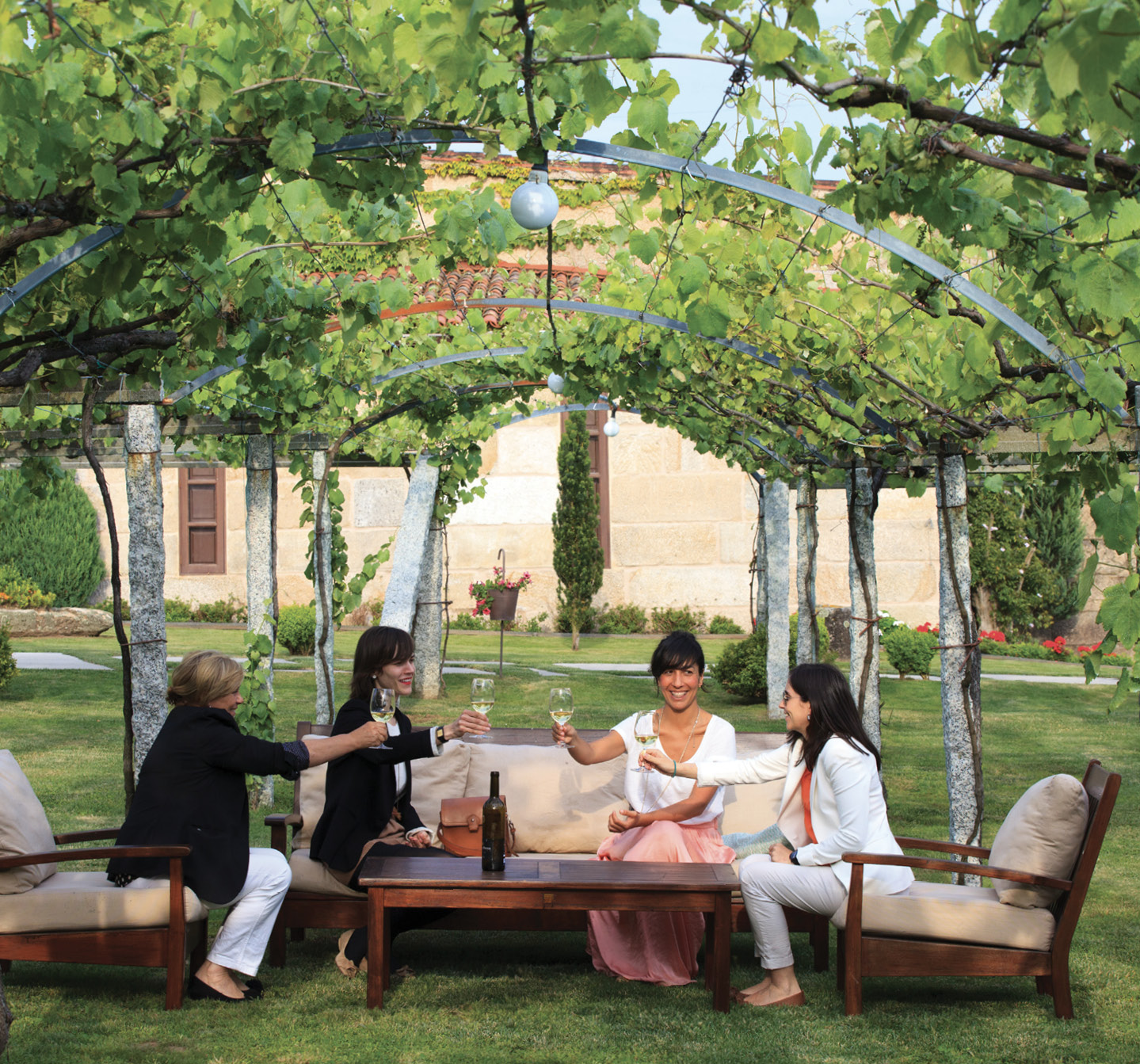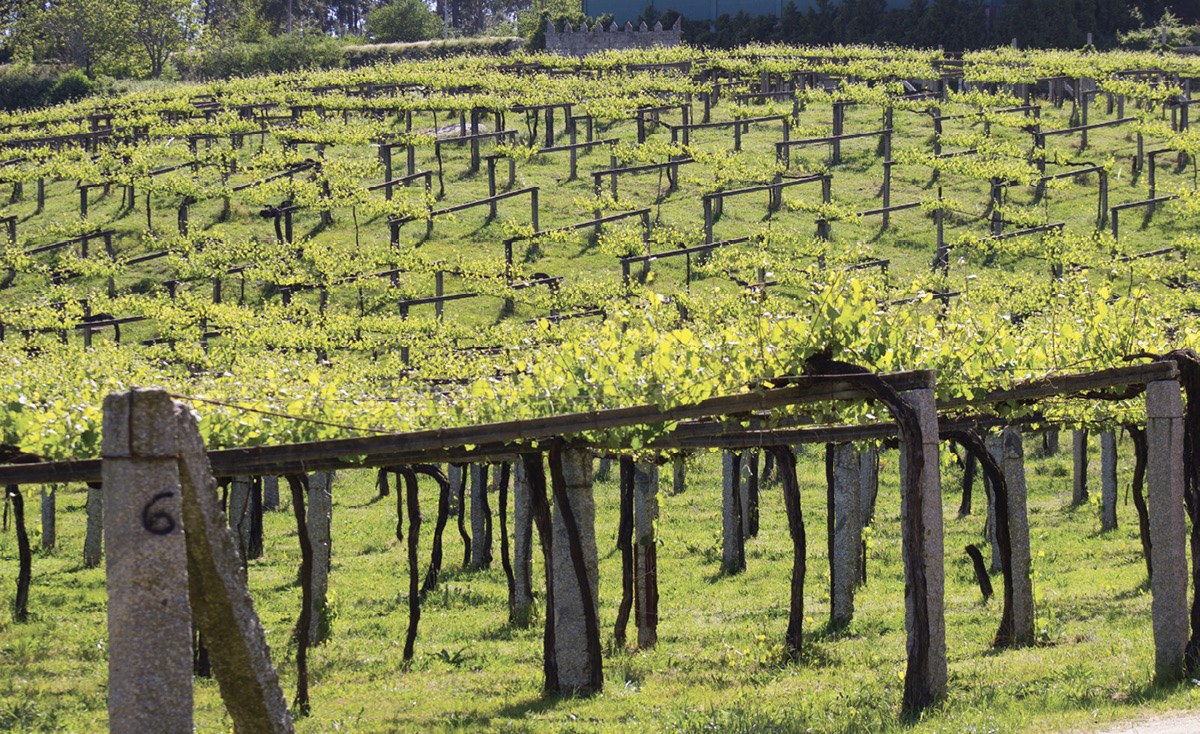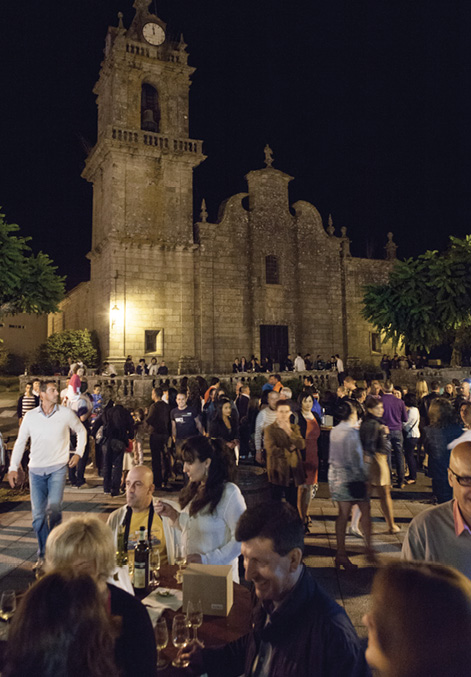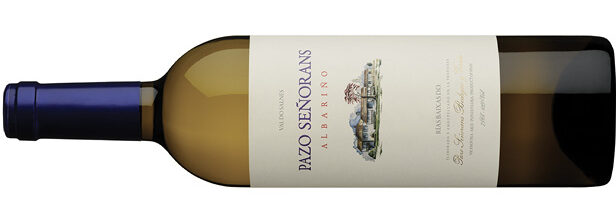
Spain’s Rías Baixas wine region in Galicia has long been influenced by its Atlantic coastline. Forget what you know of flamenco, paella and the scorched plains of La Mancha. This lush green corridor of northwest Spain has a Celtic vibe, a 2,000-year legacy handed down from seafaring tribes who settled in the rocky, verdant landscape. To this day, the kilt-wearing, bagpipe-playing locals speak their own Gallegan language and look to the sea for industry and inspiration. This is the homeland of Albariño, an elegant white grape variety as original as the place it comes from.
Flying into the coastal town of Vigo, just 30 minutes from the vineyards of Rías Baixas, your first view of the Atlantic is likely to be obscured by cloud cover, hanging over the region like a soft duvet. Ample rainfall and chill temperatures make it tough to ripen reds (less than 1% of total production in this region), but this hardly matters to local Albariño growers. The grape has been in Galicia for a very long time, dating back to the Roman era and possibly earlier. Thick-skinned and adapted to the cool, wet conditions, Albariño over delivers on bright aromatics and naturally high acidity. The wines are crisp, light and fresh, tasting of sea spray and minerality, a perfect match for the renowned seafood of the region.


If you’re looking at a map of Galicia, the capital city of Santiago de Compostela lies north of Rías Baixas. Santiago is the grand finale of the Camino de Santiago, the pilgrimage across northern Spain that has drawn visitors to Galicia since medieval times. Further south, coastal waters carve jagged paths to the interior that become rivers and inlets. These are the five Rías Baixas, or lower estuaries, that lend their names and personalities to the wine country. Each Ría has a distinct character and all are rich in maritime charm.
The Ría de Pontevedra is named for a picturesque Roman town that houses boutiques, tapas bars and the local wine council. The southernmost Ría de Miño serves as the natural border between Spain and Portugal, a wide one-mile stretch of water that shelters ancient Celtic sites and the fishing village of A Guarda. The Ría de Vigo harbors the enchanting Cíes Islands, with the most beautiful beaches in Spain that you’ve never heard of. Savvy travelers know to bypass the crowds of Ibiza in favor of summer getaways to Rías Baixas.




Albariño is grown in five distinct subzones that collectively comprise the Denomination of Origin, or DO, Rías Baixas, the official wine designation on the label. Val do Salnés, the self-proclaimed birthplace of Albariño, surrounds the town of Cambados, with the highest concentration of vineyards and wineries. The cool coastal location on granitic soils infuses Albariño with salty minerality and citrusy character. The southernmost O Rosal subzone borders Portugal; the climate is slightly warmer, resulting in generous peach and nectarine flavors. Here, Albariño might be bottled as a single varietal or blended with other heirloom grapes, like Loureiro, Treixadura, Caíño Blanco and Godello. More inland, Condado de Tea is named for a tributary of the Miño River, where Albariño thrives. The softer, round wines reflect the warmer, drier conditions of the vineyard sites. Further north, cool breezes build brisk character into the tiny Soutomaior district and Ribeira do Ulla, the northernmost subzone.


Traditional practices are prevalent throughout Rías Baixas, with many small family holdings. Some larger estates are called pazos, the regional term for manor house, which can refer to a modest farmhouse or a more aristocratic palacio. Local growers of all sizes elevate the grapes on parras, large granite canopies that allow air to circulate around the fruit and keep it from rot (a hazard of the humid conditions). Harvest is mostly by hand, a labor-intensive step to ensure that the grapes are of the highest quality. And in an interesting footnote to Atlantic culture, more than 50% of the winemakers are female, a holdover from the days when women managed affairs on land while the men of Galicia were at sea.

BURGÁNS 2022
($20)
100% ALBARIÑO. CITRUSY, WITH GREEN APPLE NOTES AND BRIGHT NECTARINE FLAVORS.

PAZO SEÑORANS 2022
($26)
AN AGE-WORTHY 100% ALBARIÑO WITH IMPECCABLE BALANCE. LEES AGING LENDS VOLUME AND STRUCTURE.

AS LAXAS SENSUM NV
($33)
A RARE, 100% SPARKLING ALBARIÑO. CLEAR AND FINE BUBBLES.
Of the 12 grape varieties permitted by DO Rías Baixas, the Albariño white varietal is the benchmark, representing more than 95% of plantings and at least 75% of blends. Innovators in the region focus on developing the personality of their subregion, and some offer small quantities of sparkling Albariño made in the Champagne method.
And while many wineries make entry-level wines to consume within two to three years of release, extended lees aging (where the wine remains in contact with the spent yeast) allows winemakers to enhance roundness and complexity, a key to extended ageing.


Very few white grapes have seen as much recent success as Albariño. So often we demand more of our reds and settle for less remarkable whites. Wine lovers know authentic character when they taste it. The best examples of Albariño reflect their Atlantic origins, making it easy to understand why the people of Rías Baixas are so committed to sustaining and cultivating their long-held traditions.
Helen Gregory is the founder and president of Gregory + Vine. She has worked in strategic brand management and communications for beverage industry leaders such as Moët Hennessy USA, Rémy Cointreau and STOLI, and has led award-winning hospitality, beverage and lifestyle campaigns for prestige clients from the European Union to Argentina, Australia, Chile, Israel, South Africa and across the United States.

